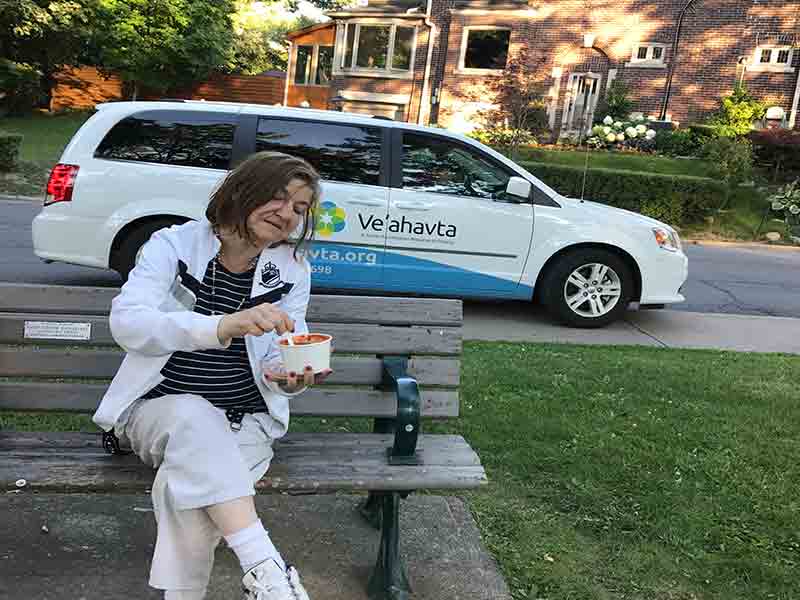On a warm Monday evening about a dozen people mill around the southeast corner of Wells Hill Park near St. Clair Avenue and Bathurst Street in Toronto. It’s 7:30 p.m. and they’re waiting for the Ve’ahavta van.
When it pulls up, they congregate at the back of the truck, where three volunteers – Judi Shostack and her twins, Alana and Jeremy Spira, 25 – begin distributing food.
Everybody gets a hot meal. There are also juice boxes, water, homemade oatmeal cookies and coffee and tea.
Meanwhile, Andre Hermanstyne, an outreach worker for Ve’ahavta, converses with the people gathered at the van. He checks to see how they’re doing, what they need.
And he’s come prepared. He’s got a large stash of sleeping bags, socks and warm clothing on hand.
This food and clothing distribution program is one of the many services offered by Ve’ahavta, a Jewish social service organization dedicated to improving the lives of people of all faiths who are living in poverty.
The van program, which operates every day but Friday, is called the Mobile Jewish Response to Homelessness (MJRH). It’s the organization’s food and clothing distribution arm, explains Marni Herskovits, director of community poverty relief.
The van makes stops on several downtown streets in an evening, usually arriving close to a set time at a particular location, she notes. “A lot of people are expecting us to be there around a similar time.”
She says the workers will also reach out to people in need in new locations. “If we hear of people in new areas … we want to give them support.”
On average, the MJRH program connects with 80 people a night.
Late last month, Ve’ahavta launched a new meal box program to provide healthy food choices for people who are homeless in Toronto, such as vegetarian burritos, steamed carrots and zucchini muffins.
“We wanted to serve people dignified, nutritious food. Just because you are homeless does not mean you should not have food that is also delicious and healthy,” says Sarit Cantor, the community engagement co-ordinator and a nutritionist who came up with the idea.
This is a pilot project funded by the Ontario Trillium Foundation. Another element to this program is that people who have experienced poverty or homelessness are given paid work placements as kitchen co-ordinators who work with volunteers to prepare the meals in kitchen space provided by Holy Blossom Temple.
Back at Wells Hill Park, Amelia Kogan sits on a bench and eats her meal. She says she’s not homeless and lives in a nearby apartment, but it’s hard for her to cook.
She is retired after a career in accounting and lives on her widow’s pension.
A man named Mark has his dinner at another bench. He admits to being a panhandler and says he struggles with addiction.
He praises Ve’ahavta. “They’re one of the best organizations I know… They’re there for you and they don’t judge or criticize.”
Another man named Ray says he used to live at Na-Me-Res, a nearby men’s shelter, but he now has a room in Rexdale. However, he still comes to the park. “It’s the only place I can get meals.”
READ: EACH MORNING, WALKING MY OWN PRIVATE CAMINO
After about half an hour, the van moves south to Wellesley and Yonge streets. There’s a younger group of about 10 people who take the food and clothing.
A man known as Pork Chop says he’s been clean for six months after 20 years of doing drugs.
Another man who does not give his name says he’s addicted to fentanyl and has overdosed several times.
Tommy, a regular, has a foot infection and takes a few pairs of socks.
The van continues south. The next stop is University Avenue and Armour Street. It’s already dark and many people have staked out their personal space for the night with blankets or sleeping bags.
They camp out on benches, on the sidewalk or under the protective canopy of a nearby office building.
People ask for sleeping bags, blankets and warm clothing. At this stop, the many requests for double-doubles keep the volunteers very busy.
The van heads further south to a stop at the bottom of Spadina Avenue and then moves west to Bathurst Street, stopping several times as it makes its way north before the shift is finished for the night.
